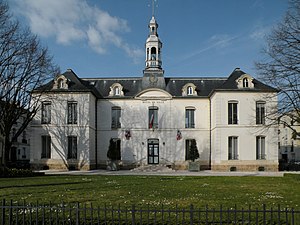Chatou
| Chatou | ||
|---|---|---|

|
|
|
| region | Île-de-France | |
| Department | Yvelines department | |
| Arrondissement | Saint-Germain-en-Laye | |
| Canton | Chatou (main town) | |
| Community association | Saint-Germain Boucles de Seine | |
| Coordinates | 48 ° 53 ' N , 2 ° 9' E | |
| height | 22-58 m | |
| surface | 5.08 km 2 | |
| Residents | 30,253 (January 1, 2017) | |
| Population density | 5,955 inhabitants / km 2 | |
| Post Code | 78400 | |
| INSEE code | 78146 | |
 Chatou City Hall |
||
Chatou is a French city with an area of 508 hectares and 30,253 inhabitants (at January 1, 2017) in the department of Yvelines in the region Ile-de-France . The altitude is 37 meters above sea level . Chatou is ten kilometers west of Paris between the cities of Rueil and Le Vésinet in close proximity to the Seine . A bridge connects it with the opposite department of Hauts-de-Seine .
history
The region around today's Chatou was already settled by the Gauls and later by the Romans . The name of the city is derived from the Latin cattus . In French, the people of Chatou are called the Catoviens .
The place was first mentioned in a document in 691 under the Merovingians . Later it was owned by the Dames de Malnoue . In the 14th century it was first a fief of the Abbey of Saint-Denis , then of the Malet family , passed to the Portail family in the 16th century and to Henri-Léonard Bertin, a high tax officer under Louis XV, in 1762 .
In 1626 the ferry , which had operated between Chatou and Rueil since 1050 , was replaced by a bridge.
In the 19th century, the place experienced an economic boom and an increase in population due to its connection to the railway line, which ran between Paris and Le Pecq from 1837 . Its proximity to Paris made it a popular place to live for wealthy industrialists who built lavish villas in the countryside and on the banks of the Seine.
In the second half of the 19th century, the banks of the Seine and the Maison Fournaise , an entertainment venue on an island, attracted many Impressionist painters such as Claude Monet , Alfred Sisley , Berthe Morisot , Édouard Manet , Guy de Maupassant and Auguste Renoir , for whom the Seine island is today's Name Île des Impressionistes (Island of the Impressionists). Around thirty enamel panels with reproductions of the paintings made in Chatou remind of the days when the railway brought townspeople looking for relaxation and cheerful artists to Chatou in the summer , where the painters set up their easels .
The following paintings were created in Chatou:
- André Derain : Winter Landscape in Chatou , 1905, oil on canvas, 61 × 81 cm, private collection
- Auguste Renoir: Spring in Chatou , 1841, oil on canvas, 74 × 59 cm, private collection
- Auguste Renoir: Rowers at Chatou , 1879, oil on canvas, 81 × 100 cm, Washington , National Gallery of Art
- Auguste Renoir: Railway Bridge in Chatou or The Pink Chestnut Trees , 1881, oil on canvas, 66 × 54 cm, Paris, Musée d'Orsay
- Auguste Renoir: The Seine at Chatou , Boston , Museum of Fine Arts
- Maurice de Vlaminck : Landscape near Chatou , 1906, oil on canvas, 65.5 × 81 cm, Staatliche Kunsthalle Karlsruhe
Attractions
- The Notre-Dame de Chatou church, which dates back to the 12th century. The Romanesque bell tower still bears witness to this time . Over the centuries the building has been steadily expanded and restored. After the partial destruction in the Franco-German War, the church was rebuilt by the French architect Paul Abadie . In 1880 the west facade was presented in neo-Gothic style .
- Former palace complex “La Faisanderie” with entrance pavilions and farm buildings (18th century). The residential wing was replaced in 1862.
- Nymphaeum (1777) by Jacques-Germain Soufflot in the palace park with a shell-shaped vault.
- Town hall (18th century) with bell tower (1879) and salons from the time of Napoleon III.
- Island of the Impressionists between Chatou and Rueil with the restaurant “Maison Fournaise”, to which a municipal museum has been attached.
- Numerous villas from the beginning of the 20th century.
literature
- Le Patrimoine des Communes des Yvelines. Volume 1, Flohic Editions, Paris 2000, ISBN 2-84234-070-1 , pp. 147-151.
Footnotes
- ↑ Gilles Malet was the founder of the National Library

